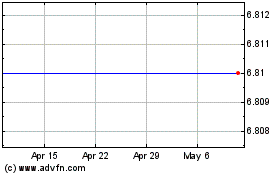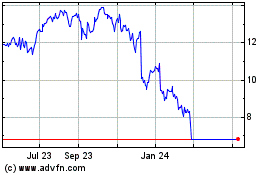Don't Give Up on Stock Buybacks, At Least Not Yet -- WSJ
May 08 2017 - 3:03AM
Dow Jones News
The programs are no longer a sure thing -- but there's still an
effect on value stocks
By Mark Hulbert
Stock buybacks are no longer considered an unambiguously good
thing, for companies or investors. But investors might still be
able to profit from them.
As recently as the 1990s, the market typically celebrated a
company's announcement that it would be repurchasing its shares in
the open market. Numerous studies found that not only would the
stock of the average company jump on the announcement of a buyback
program, it also would continue to outperform the market for
several years.
Today, in contrast, the announcement of a buyback program is
often met with cynicism if not outright criticism. Many believe
that such programs have become little more than short-term
financial engineering that sacrifices a company's long-term
growth.
Recent studies have found that the stock of the average company
engaged in repurchasing its shares performs no differently than the
overall market.
What changed? One big factor is that, starting about 15 years
ago, the stock market became more efficient -- leaving fewer shares
mispriced -- for several reasons, including the increasing
influence of big, sophisticated institutional investors, more
information disclosure by companies because of increased
regulation, improved market liquidity due to a decline in trading
costs, and an explosion in algorithmic trading, according to
research conducted by Fangjian Fu and Sheng Huang, finance
professors at Singapore Management University.
A more-efficient market leaves fewer opportunities for companies
to buy back their shares at bargain prices with the goal of
profiting from a rebound, so buybacks now tend to be done more for
business reasons than purely market reasons, according to a study
the professors published last year in the journal Management
Science. That makes a jump in share price after a buyback less
likely.
The net result of this and other factors, according to the
study, is that on average companies have stopped experiencing any
boost in the performance of their shares following the announcement
of a buyback program. The data the published study was based on
ended in 2012, but Dr. Fu says he has updated the study to include
data through the end of 2016 and reached the same conclusion.
Opportunity knocks
But there is still the possibility that investors can exploit
some repurchase announcements, according to Gustavo Grullon, a
finance professor at Rice University. He says he has found from his
research that among certain stocks the market continues to react
favorably to a buyback announcement.
These are so-called value stocks -- shares that trade below the
level that would be expected given a company's revenue, sales and
other financial data -- especially those of companies with the
smallest market capitalizations. Their performance after buyback
announcements gets lost in the aggregate data because their buyback
programs are often tiny compared with those of the largest
companies, Dr. Grullon says.
One reason these stocks are more likely to get a boost from
buybacks is that the market for them is less efficient than the
market for bigger stocks, Dr. Grullon says, in part because fewer
sophisticated investors and Wall Street analysts follow the smaller
companies. That leaves more room for significant price increases.
And, Dr. Grullon adds, those increases tend to happen gradually
because of that same inattention to these stocks, leaving time for
investors to take advantage.
Another factor, he says, is that investors differentiate between
companies that appear to be engaging in buybacks for short-term
reasons and companies that are adding to their long-term value by
repurchasing their shares.
Companies that fall into the first category tend to be so-called
growth companies, which have plenty of opportunities to invest cash
in their growth. The market frowns on such companies if they decide
not to invest in those growth opportunities and instead spend their
cash on buybacks, Dr. Grullon says.
Counting on value stocks
The situation is different for value stocks, since they are out
of favor and the companies have fewer opportunities to invest in
their growth. In such cases, Dr. Grullon says, the action that
promises the greatest rate of return may be for these companies to
buy their undervalued shares and hope to profit from the market's
eventually pricing the shares more fairly.
Share prices won't jump every time a company buys back a
small-cap value stock, Dr. Grullon says, but his research has found
that on average the price will rise.
Among the investment newsletters I monitor, the Buyback Letter
(edited by David Fried) comes closest to pursuing this approach to
buyback stocks. And, sure enough, its model portfolios have
continued to beat the broad market, even as the average buyback
stock has struggled in recent years to keep pace with a simple
index fund.
Here are the smallest-cap stocks that Mr. Fried has recommended
to clients in recent weeks that have particularly low price-to-book
ratios, one of the major criteria for determining which stocks fall
into the value category: Allscripts Healthcare Solutions (MDRX);
Investors Bancorp (ISBC); Kohl's (KSS); Myriad Genetics (MYGN) and
PennyMac Mortgage Investment Trust (PMT).
To be sure, the Buyback Letter hasn't beaten the market in
recent years by as much as it has over a longer stretch. Mr.
Fried's average model portfolio has beaten the dividend-adjusted
Wilshire 5000 index's annualized return by 3.7 percentage points
over the 20 years through April 30, but by only 1.6 percentage
points over the trailing five years.
But that's still much better than the average buyback stock's
performance. And a statistician cannot at the 95% confidence level
conclude that the Buyback Letter's deterioration in performance is
due to anything more than random fluctuation in the year-by-year
results. It's worth noting in this regard that the Buyback Letter
over just the past 12 months has beaten the Wilshire 5000 by 4.8
percentage points.
Mr. Hulbert is the founder of the Hulbert Financial Digest and a
senior columnist for MarketWatch. He can be reached at
reports@wsj.com.
(END) Dow Jones Newswires
May 08, 2017 02:48 ET (06:48 GMT)
Copyright (c) 2017 Dow Jones & Company, Inc.
Veradigm (NASDAQ:MDRX)
Historical Stock Chart
From Mar 2024 to Apr 2024

Veradigm (NASDAQ:MDRX)
Historical Stock Chart
From Apr 2023 to Apr 2024
